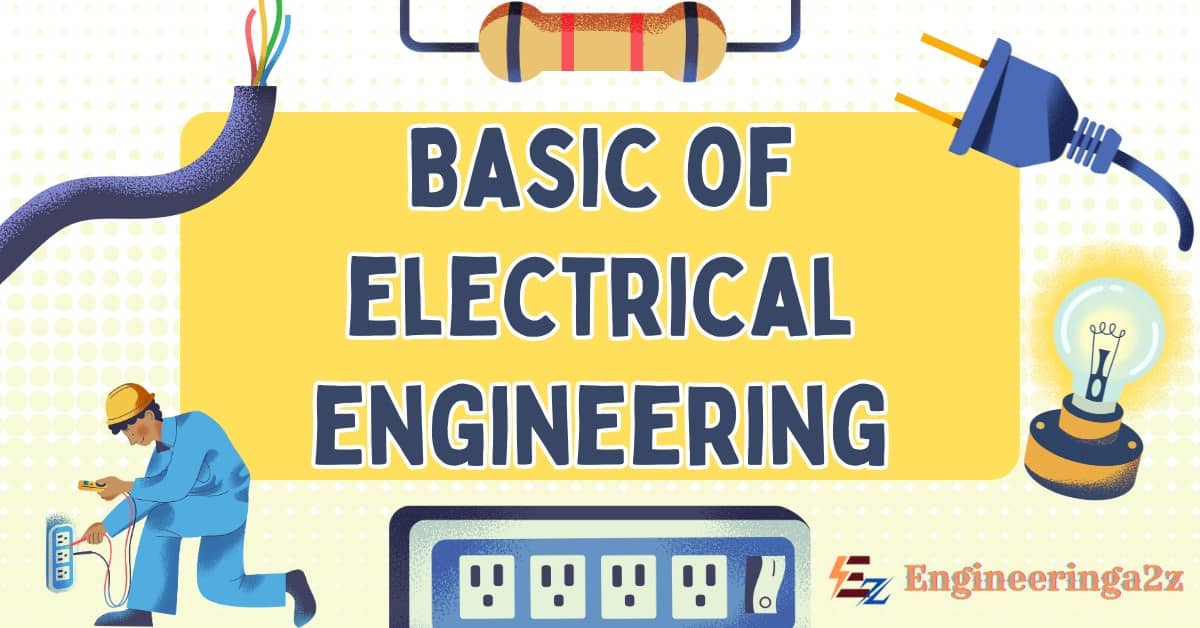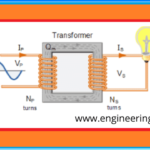
Table of Contents
-
What is electrical engineering?
Electrical engineering is an engineering discipline concerned with the study, design and application of equipment, devices which use electricity, electronics, and electromagnetism.
-
What is electric current?
The flow of an electric charge between two points is known as an electric current. A charge of 1 coulomb flowing in 1 second equals 1 ampere of current. The current formula is given as I = V/R.
The SI unit of electric current is Ampere. -
What is voltage?
The potential difference between two points in an electric field causes current to flow in the circuit, which is known as voltage.
The SI unit for voltage is Volt and is represented by the letter V. -
What is power?
The time rate at which work is done by a force is said to be the power due to that foce.
The SI unit of power is Watt (W) -
What is power factor?
Power factor is defined as the cosine of the angle between voltage and current.
The phase difference between voltage and current in AC circuits must ideally be zero. However, there is a phase difference between the two in practise. The power factor is defined as the cosine of the phase difference between the two. -
What is energy?
It is define as, capacity to do work is called energy. It is scalar quantity. Energy is available in many forms like; kinetic energy, potential energy, gravitational potential energy, electrostatic potential energy, etc.
The SI unit of energy is Joule. -
What is resistance?
The obstruction offered by a conductor in the path of flow of current is called its electric resistance.
The SI unit of resistance is Ohm. -
What is reactance?
The opposition offered by an inductor or by a capacitor in the path of flow of alternating current is called reactance. It is of two types of inductive reactance and capacitive reactance.
-
What is capacitance?
The capacitance of conductor is the amount of charge needed in order to raise the potential of the conductor by unity.
The SI unit of capacitance is Coulomb/Volt or Farad. -
What is impedance?
The opposition open by and AC circuit containing more than one out of 3 components L, C and R is called impedance of the circuit.
The SI unit of impedance is Ohm. -
What is dielectrics?
Dielectrics are insulating materials which transmit electrical effect without actually conducting electricity. Examples are mica, glass, water etc.
-
What is magnetic induction?
The magnetic flux passing through per unit normal area, is called magnetic induction.
The SI unit of magnetic induction is Weber/meter2 or Tesla. -
What is self induction?
The phenomenon of production of induced emf in a circuit due to change in current flowing in its own, is called self induction.
-
What is mutual induction?
The phenomenon of production of induced EMF in a circuit due to change in magnetic flux in its neighboring circuit is called mutual induction.
-
What is mutual inductance?
Mutual inductance of a pair of coils is defined as the magnetic flux linked with one coil when a constant current of unit magnitude flows through the neighboring coil.
The SI unit of mutual inductance is Henry -
What is magnetic flux?
The number of magnetic line of forces passing through any surface is called magnetic flux linked with that surface.
The SI unit of magnetic flux is Weber. -
What is electromagnetic induction?
When a coil is rotated in a uniform magnetic field and induced emf is produced between its ends. The direction of induced emf is alternating in nature.
-
What is ac generator?
It is a device that converts mechanical energy into electrical energy. A generator works on the principle of electromagnetic induction.
-
What is motor?
A motor is a device that converts electrical energy into mechanical energy its working is based on the fact that when a current carrying coil is placed in a magnetic field in a torque acts on it torque acting on a current carrying coil placed in a uniform magnetic.
-
What is ac inverter?
An inverter is an electronic & electrical device that converts direct current (DC) into alternating current (AC). It is the reverse process of rectification.
-
What is transistor?
A transistor is a semiconductor device that is used to amplify or switch electrical signals and power. The transistor is a basic component of modern electronics.
-
What is diode?
A diode is a two-terminal electronic component that conducts electricity primarily in one direction. It has high resistance on one end and low resistance on the other end.
-
What is rectifier?
A rectifier is an electronic device that converts alternating current (AC) to direct current (DC) by using one or more P-N junction diodes.
-
What is chopper?
A chopper is a device that converts a fixed DC voltage into a variable DC voltage. In a chopper circuit thyristor acts as high speed switch.
-
What is ohm,s law?
According to ohm,s law, physical conditions like temp., pressure, mechanical strain etc. are kept constant than the current flowing through a conductor is directly proportional to the potential difference across its ends. i.e. V=IR
-
What is kirchhoff’s laws?
There are two kirchhoff’s law for solving complicated circuits.
First law – The algebraic sum of the current flowing into a junction is zero. it is based on conservation law of electric charge.
Second law – The algebraic sum of the potential difference in a closed loop is equal to zero. It is based on conservation of energy. -
What is electric cell?
An electric cell is a device that converts chemical energy into electrical energy. It is of two types i.e. primary cell and secondary cells.
-
What is energy?
It is define as, capacity to do work is called energy. It is a scalar quantity. Energy is available in many forms like; kinetic energy, potential energy, gravitational potential energy, electrostatic potential energy, etc.
The SI unit of energy is Joule. -
What is electromotive force?
The energy given by a cell in flowing unit positive charge throughout the circuit completely one time, is equal to the emf of a cell.
The SI unit of emf is volt. -
What is an electrical circuit?
A complete traversed path for the flow of electric current, consisting of a source of supply, connecting wires, switches, and load resistances, is known as an electric circuit.
-
What is relay?
Relay is a protective device that detects the faults and initiates the operation of circuit breaker. The relay detect the abnormal condition in the electrical circuit by constantly measuring the electrical quantity which are different under normal and abnormal condition.
-
What is circuit breaker?
A circuit breaker is a switching device which can be operated manually and automatically for protect an electrical circuit from damage caused by overload of electricity or short circuit.
-
What is conductor?
In electrical engineering, a conductor is an object or type of material that allows the flow of charge (electrical current) in one or more directions.
-
What is semiconductor?
Semiconductors are materials with conductivity that lies halfway between conductors and insulators.
-
What is insulator?
An electrical insulator is a material in which electric current does not flow freely. The electrons in the insulator’s atoms are tightly bound and cannot easily move.
-
What is Fuse?
In electrical engineering, a fuse is an electrical safety device that protects an electrical circuit from overcurrent.
-
What is MCB?
MCB stands for Miniature Circuit Breaker. During any abnormal condition in the electrical network, such as overload or short circuit, it automatically switches off the electrical circuit.
-
What is ELCB?
ELCB stands for Earth Leakage Circuit Breaker. An earth leakage circuit breaker (ELCB) is a safety device used in electrical installations with high earth impedance to prevent shock.
-
What is RCCB?
RCCB stands for Residual Current Circuit Breaker. RCCB is an essential protective device in your electrical circuit that helps to prevent electrical hazards in cases of earth faults.
-
What is corona effect?
The corona effect is a phenomenon that occurs when the surrounding air around a conductor is ionised, resulting in a luminous glow and hissing noise.
-
What is switchgear?
In an electric power system, switchgear is composed of electrical disconnect switches, fuses or circuit breakers used to control, protect and isolate electrical equipment.
-
What is multimeter?
A multimeter is an electronic device that measures voltage, current, and resistance in circuits. It can also be used to check for electrical continuity between two points in a circuit.
It has two types :
1. Digital multimeter
2. Analog multimeter -
What is earthing?
Earthing is the process of transferring charges directly to the earth through low resistance wire, resulting in an immediate discharge of electrical energy.
-
What is per unit system?
The per unit system of any quantity is defined as the ratio of the actual value in any unit and the base value in the same unit.
Per unit value = Actual value / Base value -
What is a transformer?

Transformer is an electrical device that transfers electricity from one circuit to another by changing the voltage level, either increasing (step-up) or decreasing (step-down) it. It works on the principle of electromagnetic induction and has no moving parts.
-
What is starter?
A starter is a device that is used for starting the motor. Its main purpose is to limit the heavy starting current.
-
What is energy meter?
Energy meter is an electrical instrument that measures the amount of electrical energy used by the consumers.
Related Posts
- Lead Acid Battery | Construction, Working and Application
- Travelling Wave Tube | Construction, Working and Applications
- Radar | Types of Radar, Advantages and Disadvantages
- Radar | Block Diagram, Working Principle and it’s Applications
- Multiple Access Techniques for Wireless Communication
- Internet of Things | Functional Block of IoT, Characteristics and Application

















Leave a Reply